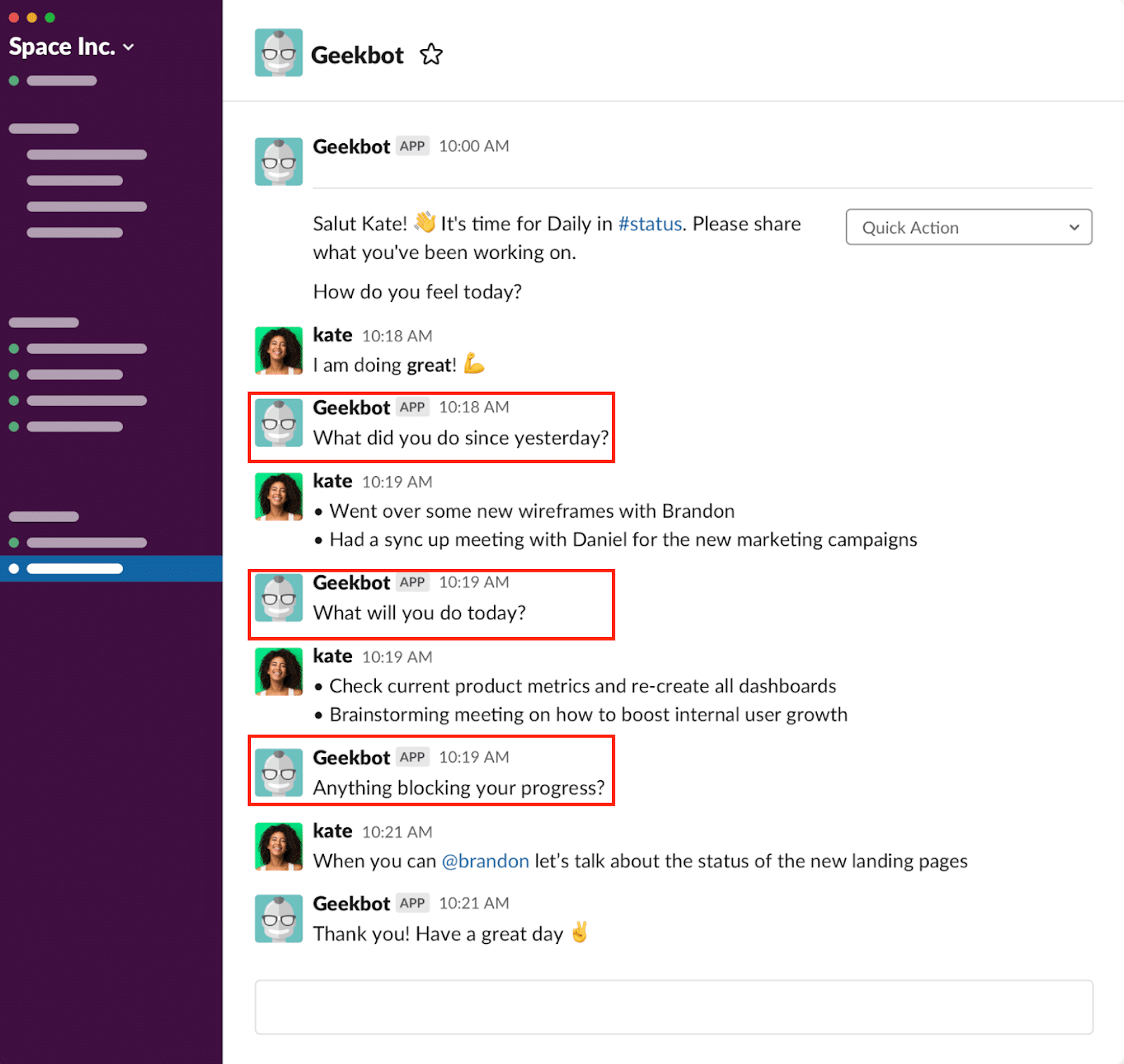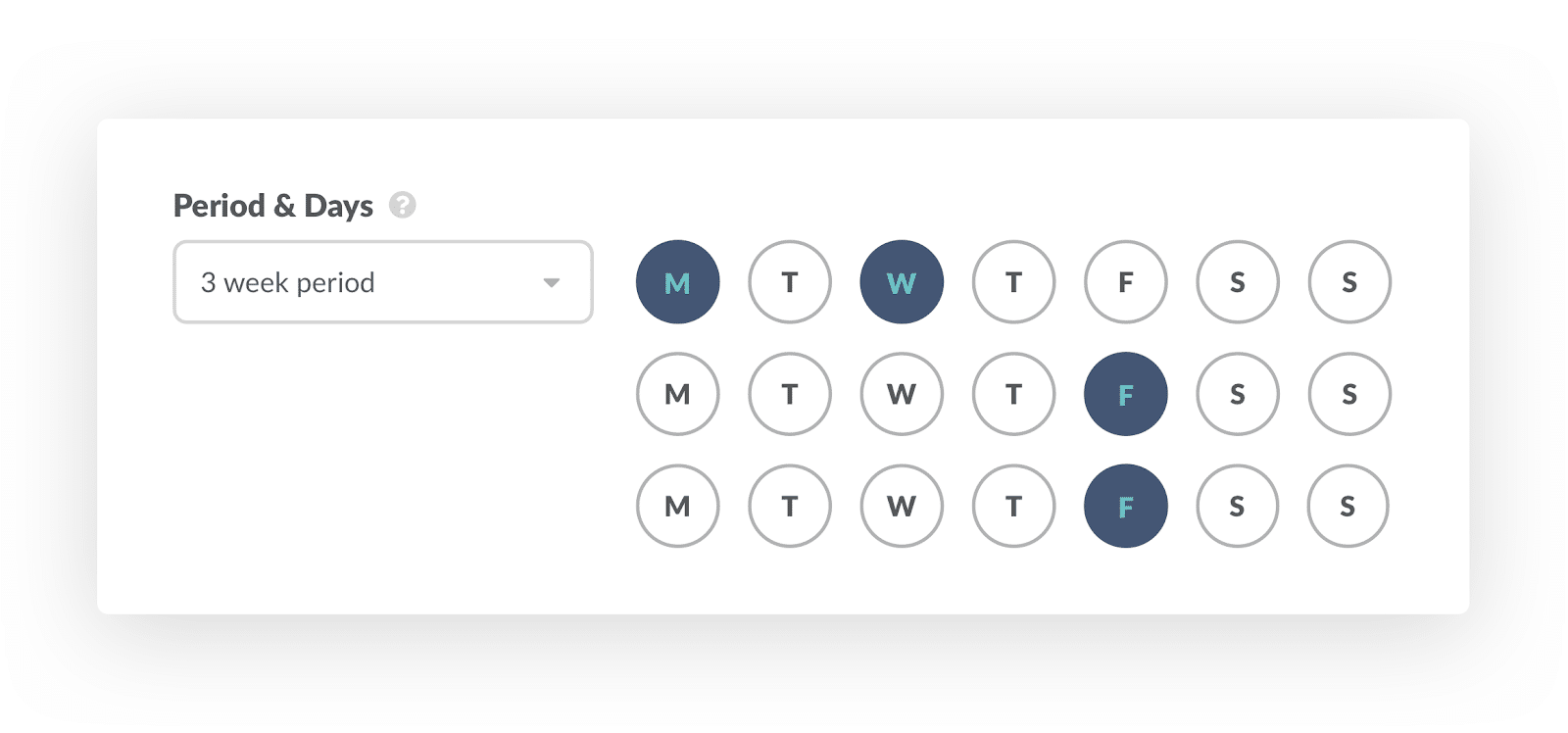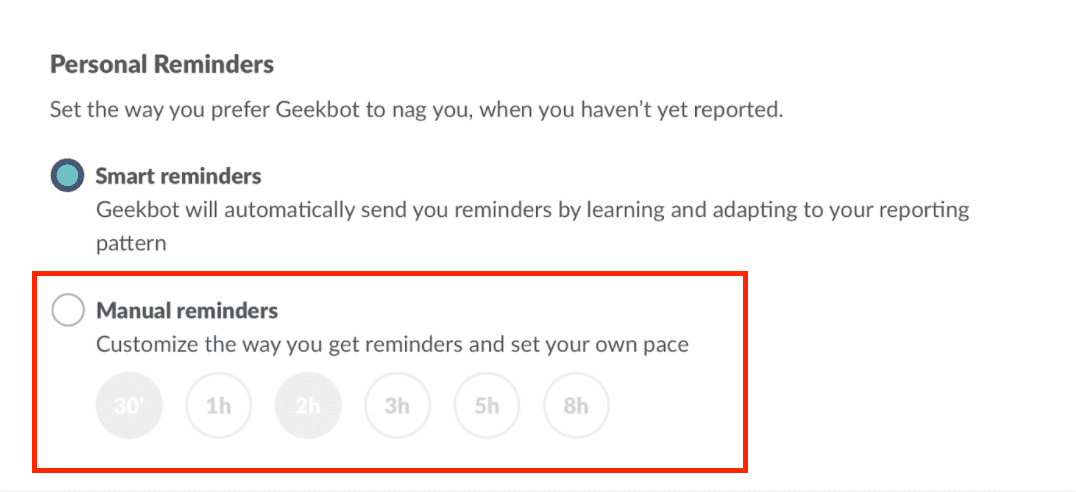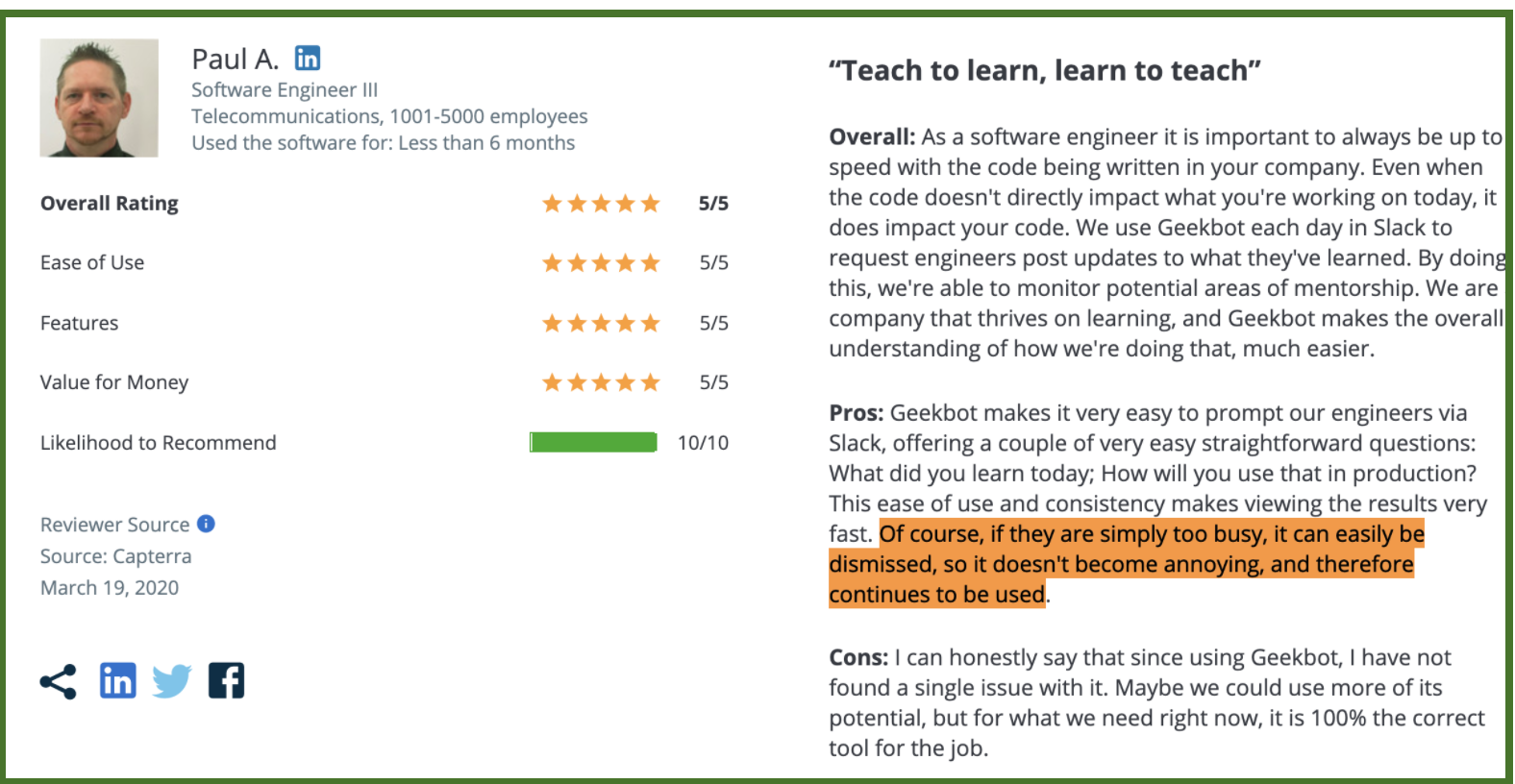We’ve run Geekbot for 5 years and in that time, talked to many teams about their standup meetings. A ton of them have the same complaint: Standup meetings are a waste of time!
We get it — we’ve felt this first hand. We started Geekbot because we felt the same way. This frustration comes from the faults of traditional, in-person (or even video-based) standup meetings, and can be avoided by doing it a different way.
Since it’s likely there are a lot more people than those we’ve talked to who also feel standups are a waste of time, we figured it’d be useful to write a post discussing this issue in detail.
In this post, we will cover:
- All the problems associated with daily standups.
- Solutions/ideas to effectively deal with these problems.
Why Do Some Teams Think Standup Meetings Are Unproductive & a Waste of Time?
If you’ve ever run a standup, you’ve probably faced this problem before…
#1: Discussing Updates That Are Unrelated to Other People’s Work
Someone starts talking about a task that is unrelated to your own work. They go on and on, while you check out mentally and pray for the meeting to be over already.
Instead of getting meaningful work done, you have to sit through an update that’s of no interest to you.
And it can get worse…
Let’s say you’re part of a 6-person team. Someone’s update may only apply to 2 other people, in which case they start having a long, elaborate discussion about the topic. In theory, a good facilitator or scrum master should step in and tell these 3 team members to huddle and discuss things after the meeting. But that’s not usually the case.
So you waste time listening to an entire discussion that’s not useful to your own work in any way.
#2: Standups Can Run Too Long Due to Oversharing, Rambling, Side Conversations, Code Reviews, etc.
From our own experience, and through talks with some of our 100,000 users, standups can take too much time for a few common reasons:
- The team is too large, so naturally, it takes a long time to get through everyone’s updates and blockers. And with more people, there’s a higher chance of tangential side conversations that waste everyone’s time.
- Someone could start rambling and overshare information about what they’ve done to impress the team (even though a simple update would’ve done the job).
- The team might start making decisions and problem-solving during the meeting.
- One of our customers said that their meetings used to turn into “long complex code reviews” or “water cool chats about the weekend”.
On the extreme side, some of our customers have told us their in-person standups used to last 1 hour. But even if a meeting overruns by 15 mins, that still takes time away from getting important tasks done. And with a 6 person engineering team, that extra quarter-hour would add up to 90 mins of non-coding time.
#3: Huge Time Cost Involved in Scheduling a Meeting Time That Works for Everyone (Time Zone Differences/Calendar Clashes)
Getting everyone on the same call is especially hard for remote or distributed teams, where everyone is in different time zones. Different schedules/calendar clashes already make it hard enough to begin with!
Someone often has to make a sacrifice and meet at an odd/inconvenient time…
One of our Geekbot customers wrote a relevant review on Capterra:

#4: The 3rd “Blocker” Question Often Leads to Problem-Solving during the Meeting
Here’s a common situation:
Someone raises a blocker (i.e. I’m struggling with debugging problem X). Three teammates jump in and offer to help. And they start having a long, elaborate discussion about the bug, even though the rest of the team may have nothing to do with it.
Instead, what they (or a project manager) should say is, “Let’s park this discussion and dive into it in more detail after the standup, because it doesn’t overlap with anyone else’s work”. But that’s not often the case…
Zapier published a relevant post about how their team uses our Slack standup bot to address this pain point:

#5: Disruptive (i.e. Standup Meeting Starts Just as You’re Making Progress on Task)
There’s nothing worse than working on a complicated problem and then having to switch modes to attend a meeting.
For example, let’s say you’re the type of person that’s extremely productive in the morning. It’s 9:00 AM, and you’ve been coding and making breakthroughs for the last 30 mins. But a standup is set to start in 2 minutes, forcing you to take your mind away from the problem at hand (just as you’re making connections in your mind and getting closer to a solution).
Then, after the standup meeting, it might take a while to remember where you left off, and get into the same type of flow and focus.
#6: Introverts Would Rather Not Speak in Front of the Whole Team
“Personally, I don’t like talking in public… or at all”
This is a common sentiment among introverted folks on many engineering and software development teams. Understandably, they don’t feel too enthusiastic about sharing updates in front of every single team member (it’s an uncomfortable feeling).
These standup meetings drain their energy, making it harder to focus on work afterwards (as opposed to extroverts who may become more energized after social interaction/communication with teammates).
Standups would be a lot more painless — and efficient — for introverts if they were done via text, instead of in-person or via video call.
Are Daily Standup Meetings Actually Ineffective & a Waste of Time?
While some of the problems above may seem extremely relatable/familiar, they’re usually a function of standups being run poorly.
Despite all the potential negatives, there’s a reason why so many engineering teams run daily scrums and follow agile methodology.
If done correctly, standups are a quick way to:
- Get up to speed on what teammates are doing and ensure everyone is focused on what matters most (i.e. only completing tasks that contribute to the sprint goal).
One of our customers on Capterra also mentioned that “even when the code doesn’t directly impact what you’re working on today, it does impact your code…”
- Foster team building and improve communication.
- Quickly identify and surface blockers to free up teammates to get their work done & clear up the backlog.
- Get a gauge for overall team health.
The real question: How do you get past all the inefficiencies of standup meetings and only reap the rewards?
The issues we’ve discussed aren’t something that you can easily circumvent by “disciplined” running of in-person standups. Proper discipline will certainly help. But it won’t make all the problems go away.
And no agile team is going to have 100% discipline in running standups since humans aren’t robots. So in-person and video call standups have flaws by their very nature.
Inevitably, the problems we’ve discussed will surface up: lengthy standups, non-relevant updates, meetings interrupting work, and so on. Those are built into the structure of an in-person standup (or video standup). And it’s very difficult to fix those issues permanently.
But we came up with an idea…
The Solution We Built to Run Quicker, More Efficient Standup Meetings Inside Slack
Before building a Slack standup bot in 2015, we were a 7-person remote team that had worked together on several projects over the years.
We used to run standups everyday via Zoom, and we faced all of the challenges listed above. In the end, standups took too long and they weren’t relevant for everyone. So the team started resenting them, and often barely paid attention. It simply wasn’t working…
So we built a solution meant to fix these problems so standups can be conducted efficiently, and teams can get the benefits of better team communication without the huge time wasting downsides that traditional standups come with.
Our tool lets teams run asynchronous standups inside Slack.
In the following section, we’ll describe how our Slack standup bot solves the problems we mentioned above, and why it works.
Logistics: How to Run Standups Inside Slack & Why It’s More Effective Than In-Person or Video
Geekbot sends a message to every team member via Slack, asking them the 3 standard scrum questions:
- What did you do yesterday?
- What will you do today?
- Anything blocking your progress?

The answers are then pushed to a public Slack channel (chosen by you).

Benefit #1: No More Lengthy Standups!
Zapier’s Strategic Apps team wrote about how they use Geekbot everyday to “shorten standups” which “can easily go off the rails”. They said, “With Geekbot, the whole thing takes about a minute or so, depending on how much you type”.
Our own team also uses Geekbot for standups everyday, and the entire process usually takes us around 5 mins in Slack (as opposed to 15 mins or more with video or in-person standups, depending on the size of your team).
Here’s an overview of the process:
- Type your status updates quickly in Slack (1-2 mins)
- Scan your team’s updates and drill down a little deeper if you find an update that applies to your own work. (1-2 mins) If not, congrats… the standup is complete. You probably have a lot of work to do, and it’s time to get to it!
- If an update or blocker requires your response, you may open up a threaded Slack conversation, or jump on a call, and correspond with the relevant person without wasting everyone else’s time (1-2 mins)
This allows teams and managers to still get the main benefit of standups: being aligned, knowing what everyone is working on, being able to help each other with challenges and blockers. But they get these benefits much quicker than video call or in-person standups.
Benefit #2: Side Discussions That Only Involve Relevant Teammates (And Don’t Waste Everyone Else’s Time)
As we just mentioned above, by using Slack, standup attendees don’t have to sit through updates that are unrelated to their own work, but any number of team members can still have elaborate discussions to problem solve on topics that are relevant to what they’re working on.
Here’s an example:

So 2 people can discuss a certain issue via a Slack thread without having to waste anyone else’s time. In an in-person standup, the entire team would’ve had to listen to their long and elaborate discussion, even if it didn’t overlap with their own work.
Benefit #3: Easier to Schedule a Meeting Time That Works for Everyone (And Takes into Account Time Zone Differences/Calendar Clashes)
The asynchronous nature of Slack is especially ideal for remote and distributed scrum teams. Geekbot gives you the option to start a standup at a user’s local timezone.


For example, you can set the daily scrum’s starting time at 9:00 AM. And if your team is dispersed around the world, then Geekbot would prompt users to share standup updates at 9:00 AM in their own respective time zone (whether it’s Los Angeles, Barcelona, Athens, or any location!)
This way, teammates don’t have to make sacrifices and meet at odd times (unlike with video or face to face standups, where everyone has to meet at the same, specific time).
To illustrate, a 9:00 AM team meeting time might work for someone in San Diego… but that’s 7:00 PM for another teammate in Greece, who doesn’t want to work past 5:00 PM or has other responsibilities.
Benefit #4: Not Disruptive (You Can Snooze the Standup and Answer the Questions at Any Convenient Time throughout the Day)
Let’s say you’re in the middle of a task and get into a zone. Suddenly, you get a notification in Slack from Geekbot, prompting you to answer the 3 standup questions.
You don’t have to drop everything you’re doing to share updates at that exact moment. Instead, you can snooze the standup and receive a reminder notification in a few hours (once you’re already done with the task).
You can customize Geekbot’s settings to send you reminders as often (or as little) as you want:

For example, you can choose to receive 3 reminders in total: one after 30 mins, one after 3 hours, and a last one after 5 hours (assuming you still haven’t completed the standup).
One of our customers said this on Capterra: “All my team members started to write daily standups without no-shows that used to happen when we tried to use calls or calendar reminders.”
But it’s important to note that the reminder feature is turned off at Geekbot by default, because we wanted our tool to be non-intrusive. You have to activate reminders via the dashboard settings.
Another one of Geekbot’s users wrote an apropos Capterra review (see orange part below)

You can also customize your entire workflow using Geekbot’s API and integrate with Trello, Jira, etc.
Final Thoughts
We’ve been using Geekbot for our own standups for 5 years and haven’t looked back. In addition, over 170,000 other users are also using Geekbot — including teams from Github, Sony, Salesforce, Airbnb, GitLab, and more.
To recap, here are the major problems associated with in-person and video call standups, and how running standups in Slack via Geekbot helps solve them:
#1: A standup takes too long and goes off the rails.
With Geekbot: Quickly type your updates in Slack and skim other people’s answers.
#2: Teammates discuss updates that are unrelated to other people’s work.
With Geekbot: You can open up a threaded Slack conversation, and correspond with the relevant person without wasting everyone else’s time.
#3: There’s a huge time cost involved in coordinating a daily meeting time that works for everyone due to scheduling issues.
With Geekbot: Slack is asynchronous by nature. As one of our customers said on Capterra, Geekbot “enables us to keep that good habit of daily reporting our work while not necessarily doing it all at the same time”.
#4: The 3rd “Blocker” question often leads to problem-solving and side discussions during status meetings.
With Geekbot: Software developers & engineers can use threaded Slack conversations.
#5: Disruptive (i.e scrum meeting starts just as you’re making progress on task).
With Geekbot: There isn’t a time limit for the standup in Slack. You can snooze the standup and answer the questions at any convenient time throughout the work day (not in the middle of an important task!).
You Might Also Like…
- Zapier Blog: Why We Replaced Our Standups with a Robot
- Analyzing The 3 Daily Standup Questions: Common Pitfalls & Unique Ideas
- Geekbot Webinar: Basic Functionality, Commands, Common Features
Frequently asked questions
How long should a stand up meeting last?
A standard stand up meeting should last no longer than 10-15 minutes. In order to ensure that this requirement is met, either a team or a Scrum Master need control the timeframe. Another often neglected factor is a team size: A Scrum team should not include more than 9 members, otherwise keeping a stand up meeting under the required timeframe becomes impossible.
What is the purpose of daily standup meeting in agile?
Daily standup meeting in agile is not your typical status meeting. Daily standups allow team members to share their current progress and challenges with their team members in a quick and effective manner, but their main purpose is to consistently align team members around their current goals and ensure nothing is in the way of their progress.
Are daily standups effective?
Daily standups are extremely effective in keeping an agile team focused on both their short-term and long-term goals. Some agile teams struggle to make standups effective, but the reason behind it almost always has to do with either improper meeting format or team attitude. Stand up meetings are never status meetings, and should last no longer than 15 minutes.



